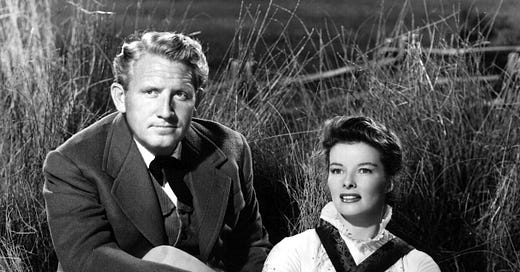The Sea of Grass and rancher violence
The Sea of Grass is a 1947 Western drama directed by Elia Kazan, about a half decade before his infamous cooperation with the House Un-American Activities Committee. The film, based on a novel of the same title, centers on a family driven apart by the violence used to maintain their ranching business. Kazan was not happy with the final result and advised readers of his autobiography not to see it.
Katharine Hepburn stars as Lutie Cameron, a Missouri woman, who marries Colonel Jim Brewton, a New Mexico cattleman played by Spencer Tracy. Alienated by her husband’s tyrannical dealings, Cameron has an affair which produces a son. Their marriage falls apart and Brewton raises the boy as his own. Cameron reconciles with the rancher decades later when her wayward son is killed.
The movie isn’t interested in the violence Brewton inflicts on his livestock. However, it’s very interested in the violence Brewton inflicts on farmers, Native Americans and wild animals. In the film’s opening minutes, the cattleman discusses the subject with his wife explicitly, setting up their later conflict over the issue. He takes Cameron to view the government-owned land where his livestock graze.
“I can remember the first time I saw her,” Brewton says. “Nobody wanted her then — except the antelope and the buffalo and the Indians. So we took her, and we set her up right for cow country. We fought for her. Our blood's sunk in every mile. Indian blood, too. I’m not so proud of some of that. My brother’s out there.” The rancher tells his wife he can still hear the Native Americans and wild animals.
Later, a farmer shoots a cow trampling on his wheat crop. Brewton’s men attack the homesteader, whose pregnant wife pulls him inside and loses the baby in the process. Cameron, who was friends with the farmer’s wife, accuses her husband of not caring how many people die so long as he retains access to grazing land. The cattleman doesn’t deny the accusation, saying homesteaders aren’t worth much.
In fact, Brewton eventually raises a small army with the intention of fighting off government forces tasked with defending prospective farmers. He almost leads his posse of ranch hands into battle. It’s only when they come face to face with the opposing soldiers that he realizes any victory on their part would be short-lived, as the government would simply send further reinforcements.
Personally, I thought Kazan’s judgement of his work was overly harsh. My biggest problem with the film, outside the obvious use of animal actors, was the final reconciliation of Cameron and Brewton. Among other things, I gather Kazan was upset by the studio’s decision not to shoot on location. Instead, he was forced to rely on rear-projection images of the Great Plains.
Writing in 1947, Bosley Crowther, the New York Times film critic, complained the movie didn’t feature the amount of action you would expect in the Western genre. “One just naturally looks for some action with horses and guns before the end,” he stated in a negative review. “But you will wait a long time — indeed, forever — for anything stirring in this line in Metro's new cow-or-plow drama.”
I’m sympathetic to Kazan’s objections to an extent, however, Bosley seemed to want a completely different kind of film. I found The Sea of Grass to be a flawed, but interesting exploration of the ways in which the status of cattle as valuable property, in need of grazing land for their economic potential to be realized, could inspire violence against wild animals, Native Americans and homesteaders.


